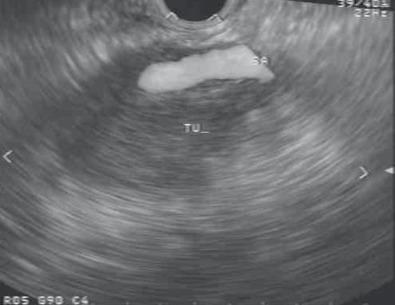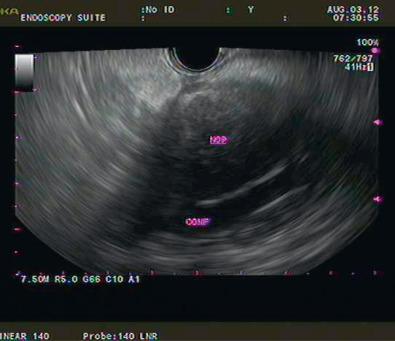Physical Address
304 North Cardinal St.
Dorchester Center, MA 02124
Examination of the pancreas and biliary structures by endoscopic ultrasound (EUS) can be technically challenging to master due to the need to recognize patterns of normal, benign, and pathologic anatomy. However, once these skills are learned, EUS permits the most detailed nonoperative view of the pancreas and the bile ducts. This chapter summarizes the role of EUS for the evaluation of solid malignant pancreatic and biliary neoplasms.
EUS is the most sensitive imaging test for the detection of all pancreatic and periampullary lesions ( Table 62.1 ). In studies that compared EUS and computed tomography (CT), the sensitivity of EUS for mass detection was superior to CT. EUS is clearly superior to conventional CT and transabdominal ultrasound (US). A few comparative studies between EUS and multidetector-row CT (MDCT) for pancreatic tumors have demonstrated the superiority of EUS for tumor detection. There are relatively sparse comparative data between EUS and magnetic resonance imaging (MRI) for tumor detection, with at least one study showing the superiority of EUS. EUS is particularly useful for identification of small tumors that can go undetected by other imaging modalities. For tumors of 30 mm or less in diameter ( Fig. 62.1 ), EUS was found in early literature to have a sensitivity of 93% compared to 53% for CT and 67% for MRI. Nowadays, with thinner slice imaging and precisely timed contrast administration coupled with multiplanar reconstruction, CT (often referred to as pancreas protocol ) may now be able to identify small pancreatic masses that previously may have been undetected by conventional or even single-detector dual-phase imaging. EUS remains the test of choice in all patients with obstructive jaundice or dual pancreatic and bile duct dilations in whom CT or MRI do not identify a lesion.
| Author (yr) | No. Patients | EUS | CT | MRI | US |
|---|---|---|---|---|---|
| Rosch et al. (1991) | 102 | 99 | 77 | 67 | |
| Rosch et al. (1992) | 60 | 98 | 85 | 78 | |
| Palazzo et al. (1993) | 49 | 91 | 66 | 64 | |
| Muller et al. (1994) | 33 | 94 | 69 | 83 | |
| Sugiyama et al. (1997) | 73 | 96 | 86 | 81 | |
| Gress et al. (1999) | 81 | 100 | 74 | ||
| Agarwal et al. (2004) | 71 | 100 | 86 | ||
| DeWitt et al. (2004) | 80 | 98 | 86 |

EUS has a few limitations including the potential failure to identify true pancreatic masses in patients with chronic pancreatitis, a diffusely infiltrating carcinoma, a prominent ventral/dorsal split, or after a recent episode (< 4 weeks) of acute pancreatitis. Therefore, a normal pancreas by EUS examination essentially rules out pancreatic cancer, although follow-up EUS or other studies should be undertaken in the setting of chronic pancreatitis due to impaired visualization. It is also important to remember that acoustic shadowing caused by an indwelling biliary or pancreatic stent may also impede visualization of a small pancreatic mass.
Due to the ability of EUS to provide high-resolution images, there has been increasing interest in using this technique to screen asymptomatic high-risk cohorts for early cancer detection. A consensus statement by the International Cancer of the Pancreas Screening Consortium recommended screening with EUS and/or MRI for the following groups: first-degree relatives (FDRs) of patients with pancreatic cancer from a familial pancreatic cancer kindred with at least two affected FDRs; Peutz-Jeghers syndrome; p16 or BRCA2 mutations; and hereditary nonpolyposis colorectal cancer mutation carriers with 1 or more affected FDRs. A 2016 comparative analysis highlighted the complementary roles EUS and MRI play in screening these high-risk individuals. MRI was found to be more sensitive for the detection of cystic lesions of any size; EUS, however, detected more solid lesions then MRI. The optimal screening modality, interval, need for fine-needle aspiration (FNA), and screening abnormalities of sufficient concern for surgery remain unknown, and further studies are required to answer these questions.
Autoimmune pancreatitis (AIP) may mimic pancreatic adenocarcinoma, and accurate preoperative detection may avoid unnecessary surgery. The EUS morphology of AIP may include diffuse pancreatic enlargement, a focal mass, focal hypoechoic areas, bile duct wall thickening, or peripancreatic lymphadenopathy ( Fig. 62.2 ). EUS-guided fine-needle aspiration (EUS-FNA) may demonstrate a nonspecific plasmacytic predominant chronic inflammatory infiltrate, but this finding has variable sensitivity and poor specificity. Diagnosis may be confirmed by EUS-guided core biopsies with staining for IgG4 plasma cells.

Imaging-based technologies such as contrast-enhanced ultrasonography (CE-EUS) may be able to differentiate pancreatic adenocarcinoma from pancreatic neuroendocrine tumors (PNETs) and inflammatory pseudotumors, which can all present as a hypoechoic mass. Whereas ductal adenocarcinomas typically demonstrate hypoenhancement, PNET and inflammatory pseudotumors are hyperenhancing or isoenhancing. A recent meta-analysis of 12 studies involving 1139 patients reported a pooled sensitivity, specificity, and receiver operating characteristic (ROC) of 94%, 89%, and 0.9732, respectively. EUS elastography is another emerging technique based on the different stiffness of benign and malignant tissue. In a meta-analysis of 13 studies involving 1044 patients, the pooled sensitivity, specificity, and ROC was 95%, 67%, and 0.90. However, several limitations to their routine use exist and include costs and the lack of both agent availability and expertise with the technique.
Staging of pancreatic malignancy is done according to the American Joint Committee for Cancer (AJCC) Staging TNM classification, which describes the tumor extension (T), lymph node (N), and distant metastases (M) of tumors, respectively. Reported accuracies of T-staging by EUS range from 62% to 94% ( Table 62.2 ). This wide variation may be due to improved detection of distant metastasis or vascular invasion by MDCT, resulting in less operative management for suspected locally advanced or metastatic disease. The exclusion of such patients may have resulted in the decreased T-staging accuracy of some recent studies compared to earlier ones. For the last decade, some tertiary referral centers will attempt to achieve negative surgical margins by surgical resection with or without reconstruction of the portal and/or superior mesenteric vein in patients with venous invasion without thrombosis or occlusion. Currently, only vascular invasion of the celiac or superior mesenteric arteries is classified as T4 cancer ( Box 62.1 ).
| Author (year) | No. Enrolled Patients | No. Patients to Surgery With Pancreatic Cancer | T Stage | N Stage |
|---|---|---|---|---|
| Rosch et al. (1992) | 60 | 40 | NR | 72 |
| Rosch et al. (1992) | 46 | 35 | 94 | 80 |
| Palazzo (1993) | 64 | 49 | 82 | 64 |
| Muller (1994) | 49 | 16 | 82 | 50 |
| Midwinter et al. (1999) | 48 | 23 | NR | 74 |
| Gress et al. (1999) | 151 | 75 | 85 | 72 |
| Ahmad (2000) | NA | 89 | 69 | 54 |
| Soriano et al. (2004) | 127 | 62 | 62 | 65 |
| DeWitt et al. (2004) | 104 | 53 | 67 | 41 |
| Shami et al. (2011) | 50 | 50 | 80 | NR |
| Tellez-Avila et al. (2012) | 127 | 48 | 71 * | NR |
TX: Primary tumor cannot be assessed
T0: No evidence of primary tumor
Tis: Carcinoma in situ
T1: Tumor limited to the pancreas, 2 cm or less in greatest dimension
T2: Tumor limited to the pancreas, more than 2 cm in greatest dimension
T3: Tumor extends beyond the pancreas but without involvement of the celiac axis or the superior mesenteric artery
T4: Tumor involves the celiac axis or the superior mesenteric artery (unresectable primary tumor)
NX: Regional lymph nodes cannot be assessed
N0: No regional lymph node metastasis
N1: Regional lymph node metastasis
MX: Distant metastasis cannot be assessed
M0: No distant metastasis
M1: Distant metastasis
Become a Clinical Tree membership for Full access and enjoy Unlimited articles
If you are a member. Log in here